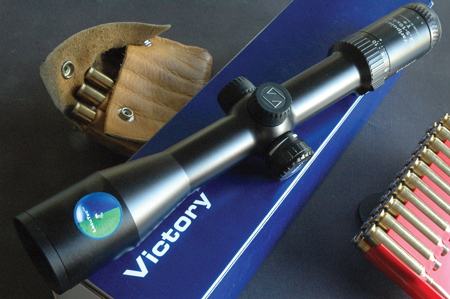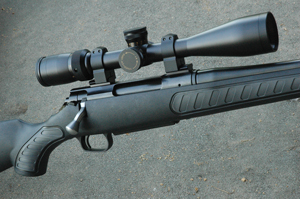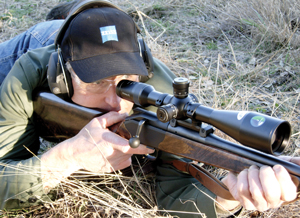 Among Author’s favorite scopes is the Zeiss Victory 2.5-10×42, available with Varipoint reticle. |
The ACOG (Advanced Combat Optical Gunsight) established Trijicon as a leading innovator in rifle optics. More than half a million have been sold. But the ACOG’s application is primarily military. The AccuPoint is Trijicon’s flagship hunting optic, a scope with two sources of reticle illumination. The fiber optic window in the ocular bell, and tritium in the reticle itself, yield a bright aiming point without batteries. An adjustable cover lets you trim light from the fiber optic coil and tune reticle brightness. Last year AccuPoint came up with plex and crosswire-and-dot reticles, as alternatives to its original super-fast delta. Lost in the lumination hype, however, has been the quality of Trijicon optics.
“It’s definitely top-drawer,” Trijicon’s Andrew Chilkewicz reminds me. I agree. Trijicon’s fully multi-coated glass gives you brilliant, razor-edged images. And if you’ve shied from lighted reticles, this is the brand to try first. Choose a delta in amber, red or green, a dot in amber or green. Combine it with a black crosswire if you like. I prefer the crosswire and amber dot. My pick among Trijicon scopes is the 3-9×40. After decades in the field, it’s still in my view the most practical for all-around big game hunting. But you can also opt for a 1.25-4×24 or a 2.5-10×56 with 1-inch tube. A 1-4×24 and a powerful 5-20×50 have 30mm tubes.
For fast shooting in ‘pole thickets, Trijicon markets reflex sights with lighted dots of various sizes. The RMR (Ruggedized Miniature Reflex) can be had with a light-emitting diode that automatically adjusts to incident light. It has an alloy housing, the Trijicon RedDot sight a nylon-polymer frame. Either can be paired with the ACOG. A battery-free RMR uses tritium and fiber optics only; the electronic version is powered by a 17,000-hour lithium battery. (Trijicon.com.)
Luminescent shotgun beads and rifle-sight inserts, with tritium and fiber-optic elements, brought TruGlo early success. Now the firm offers red dot sights and rifle-scopes too. Waterproof and compatible with any Weaver-style mount, the red dot sights come in reflex (open) configuration or 1-inch and 30mm and 40mm tubes. Dual-Color (red and green) Multi-Reticles come standard in some models.
 This T/C Venture wears a new Nitrex scope. ATK owns Nitrex, now under the Weaver label. |
All versions of the tube sight have unlimited eye relief, multi-coated lenses, click-stop windage/elevation adjustments, an 11-level rheostat to control reticle brightness. Reflex red dot sights weigh as little as 2 ounces, carry a 4-minute dot with manual and light-sensitive automatic brightness modes. TruGlo markets several series of rifle-scopes, topped by the Maxus XLE in 1.5-6×44, 3-9×44 and 3.5-10×50. The Infinity 4-16×44 and 6-24×44 have adjustable objectives. To make long-range hits easier across a variety of loads, each comes with three replaceable BDC elevation knobs.
Tru-Brite Xtreme Illuminated rifle-scopes feature dual-color plex and range-finding reticles. Pick a 3-9×44, 3-12×44 or 4-16×50. Muzzleloader versions are available. The 4×32 Compact scope for rimfires and shotguns, 4×32 and 1.5-5×32 illuminated sights for crossbows round out TruGlo’s stable of 1-inch scopes. TruGlo line of illuminated iron sights includes a fiber optic AR-15 gas block front sight with protected green bead. (Truglo.com.)
Vortex
New Razor scopes from Vortex reflect the growing interest in tactical sights. The 1.4-4×24 has a 30mm tube, the 5-20×50 a 35mm tube. Both scopes deliver brilliant images from extra-low-dispersion lenses. Lighted, etched-glass reticles lie in the first focal plane. A zero-stop mechanism in the elevation dial prevents it from spinning past sight-in setting, for fast return to zero. Vortex matches turrets with reticles; and you can specify mil-dot graduations, or minutes of angle. More practical for most hunters are Vortex Vipers. Also available in tactical guise, they come in six versions and five power ranges. I prefer the 3-9×40 (14 ounces) and 4-12×40 (17 ounces). Choose from six reticles, including dot, BDC and mil-dot. The Viper line features both 30mm and 1-inch tubes. More affordable Vortex Diamondbacks have 1-inch tubes only, as do entry-level Crossfires. All boast fully multi-coated optics.
The widest selection in the Vortex family comes under the Crossfire banner. That line includes 2-7×32 and 4×32 sights for rimfires, a 2×20 handgun scope and a 3×32 for crossbows. As with the Vipers, you get tall target knobs (and 30mm tubes) on the most powerful scopes. Specify a mil dot or illuminated mil dot reticle on the 6-24×50 AO. Vortex also lists a red dot sight, the Strikefire, with fully multi-coated lenses. Choose red or green dot to suit conditions. The sight has a 30mm tube and weighs 7.2 ounces. It has unlimited eye relief, comes with a 2x optical doubler.
The new, shorter Sparc red dot sight weighs just 5 ounces and features a one-piece, multi-height base, a 2-minute dot. Like the Strikefire, it is parallax-free beyond 50 yards and comes with a doubler. Fully multi-coated optics of course. In spotting scopes Vortex catalogs two Nomad models, both with your choice of straight or angled eyepiece. The 20-60×80 and the budget-priced 20-60×60 accept adapters for most pocket-size digital cameras. At the top end, there’s the Razor HD spotting scope with apochromatic lenses and an 85mm objective. It weighs 66 ounces with an angled 20-60x eyepiece. The die-cast magnesium alloy body is argon-gas purged. It has coarse and fine focusing wheels. (Vortex.com.)
Eight decades after Bill Weaver’s 330 led a trend away from iron sights, Weaver is re-introducing the 330’s progeny, the iconic steel-tube K4. More than any other scope, the K4 confirmed the value of optical sights for my generation of hunters. The new version has a Dual-X reticle that doesn’t move off-center in the field when you adjust windage and elevation! While the K4 may be all you need on that ’06, Weaver offers more for 2010. The Super Slam series now includes a 1-5×24 Dangerous Game sight with heavy Dual-X that should excel in thickets.
Besides the Grand Slam, Classic V, Classic K and T-series scopes, there’s now a Buck Commander line, with 2.5-10×42, 3-12×50 and 4-16×42 models. Prices start at just $280, retail. For close shooting, Weaver offers a red/green dot sight with five brightness settings. It has a 30mm tube, an integral Weaver-style base. Tactical sights will probably proliferate, as the shooting public is not that of Bill Weaver’s day. Thus, the firm announced in 2009 a 4-20×50 Tactical scope with 30mm tube, front-plane mil dot reticle and side-focus parallax dial. But you can still buy a K-series fixed-power hunting scope (one of the most-overlooked bargains in rifle sights). Among target scopes, I like the T-24. It offers a 1/2-minute or 1/8-minute dot reticle. Target adjustments on dual-spring supports ensure repeatable changes.
New Classic binoculars have been added to Weaver’s line this year: 8×32, 8×36 (my pick), 8×42, 10×42. ATK, parent company to several shooting-industry brands, counts Nitrex as well as Weaver in its family. Early in 2010, Nitrex became part of the Weaver fold, although the lines remain separate. Nitrex TR One scopes (similar to Weaver’s Grand Slam) are joined by TR Two (Super Slam) scopes with additional reticles: glass-etched EBX (ballistic), dot and illuminated. These sights boast five-times magnification – 2.5-10×42 to 4-20×50 – and turret parallax dials. Pull-up, resettable windage and elevation knobs need no caps. The TR One series includes a new 4-15×50 AO scope. (Weaveroptics.com, Nitrexoptics.com.)
Zeiss
 Author fires a Blaser R8 with a Zeiss 6-24×56 scope, one of three new Victory Diavaris this year. |
Brisk sales of Conquest rifle-scopes several years after their introduction confirm their appeal to shooters keen for value. I like the 4×32; if you must have a variable, the 2-8×32 and 3-9×40 make sense. The 4.5-14×44 milks the reach of hot-rod cartridges but looks good on lightweight hunting rifles. Like the 6.5-20×50, it features a turret-mounted parallax dial.
By the way, Zeiss has just cut the list price on its 3-9×40 Conquest from $499 to $399! While there’s little new in the Conquest stable for 2010, the top-rung Victory series boasts an up-grade of the 6-24×72, a 34mm scope introduced in 2005 but now with quarter-minute clicks and FL glass. Two new Victory scopes also incorporate fluorite lenses. I used a 6-24×56 recently, on a super-accurate Blaser R8 in .300 Winchester.
At 600 yards, prone, it was no trick to reduce a plastic pail to splinters. The 4-16×50 is better suited to hunting rifles, and should be on your short list if you expect long shooting. But for all-around hunting there’s no better sight than the Victory 2.5-10×42. With four other Victory scopes, it’s available with Varipoint, an illuminated dot in the second focal plane complementing a black first-plane reticle. So the main reticle stays in constant relationship to the target (for easy ranging), while the dot subtends a tiny area even at high power. A left-side turret knob controls dot brightness on the 1.1-4×24 Victory. The 2.5-10x42T*, 2.5-10x50T*, 3-12x56T* feature automatic brightness control.
Zeiss has just introduced a Compact Point red dot sight. Its 3.5-minute dot has five brightness levels. Weight: less than 3 ounces with two 3V lithium batteries. The 8×45 and 10×45 T* RF binoculars introduced last year have proven themselves afield, with a laser range-finding unit that requires no “third eye” emitter but delivers 1,300-yard range on reflective targets.
This unit is fast – you get a read in about a second – and the LED self-compensates for brightness. The binocular itself has peerless optics, with a rain-repellent LotuTec coating on ocular and objective lenses. You can program the RF with computer data to get holdover for six standard bullet trajectories. Zeiss still sets the bar for laser-ranging scopes, too, with its 3-12×56 Diarange. The Zeiss PhotoScope is a 20-60×80 DiaScope spotting scope with a 7-megapixel digital camera built in. The 15-45x power range affords you the equivalent of a 600-1800mm zoom in a 35mm camera – plus a 68-degree field at 15x, which Zeiss claims is 40 percent wider than normal.
The camera uses a 7.4-volt lithium ion battery and SD card to deliver images in standard file formats. PhotoScope 85T* FL weighs 6-1/2 pounds. And yes, it does produce images that qualify for full-page prints! (Zeiss.com/sports.)
This article is an excerpt from Gun Digest 2011. Click here to get your full copy!








